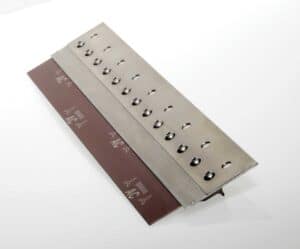Doctor blades and scraper blades are used in a wide range of manufacturing processes, such as pulp and papermaking, as well as metals, food, and other material processing applications. They enhance product quality and improve production with precise metering and materials control.
But whatever the application, there are common wear characteristics that must be assessed on an ongoing basis in order to maintain product quality, maximize production efficiency, and reduce downtime. Here is a quick list of what to look for in blade appearance and symptoms, the probable causes, and what can be done to remedy the situation:
Uneven Wear/Frequent Blade Changes
- Probable Causes
- Poor roll surface
- Damaged or dirty blade holder
- Deposits
- Remedy
- Use a more flexible blade
- Clean, repair or replace the holder
- Use an abrasive blade
Excessive Wear in Center of Blade or at the Ends
- Probable Causes
- Blade is not machined to the roll crown
- Old blade is sagging into/away from the roll
- Remedy
- Refit and shim the blade holder to the blade back as necessary; if there is a mismatch, return the new blade to be re-planed
- Replace old, sagging blade
Excessive Wear on One End
- Probable Causes
- The blade is misaligned; not parallel to roll axis
- Remedy
- Shim or move bearings and brackets as necessary to align the blade to be parallel to the roll axis
Even Wear, But Rough Edge
- Probable Causes
- Deposits on roll
- Excessive pressure on blade
- Blade material is too hard
- Remedy
- Use an abrasive blade as required
- Reduce pressure
- Use a softer blade
Excessive Wear in Sheet Run–Pulp & Paper Application
- Probable Causes
- Deposits are being left on the roll by the sheet
- Remedy
- Use an abrasive blade as required
- Trim blade edges frequently
- Use end-slotted blades to prevent build-up of excessive pressure on roll ends
Excessive Wear Outside of Sheet–Pulp & Paper Application
- Probable Causes
- Sheet lubricates the roll
- Remedy
- Use slot blade ends to relieve pressure
Localized Pitting
- Probable Causes
- Blade attacked by electrostatic discharge; electrolysis; heat
- Remedy
- Insulate blade from machine frame or use non-metallic blade
Blade Develops Feathered Edge
- Probable Causes
- Blade material is too soft
- Excessive pressure
- Blade angle is too flat
- Remedy
- Use harder blade
- Reduce pressure
- Move bearings or brackets to increase angle; check for correct blade angle with gauge
Hooks on Blade Outside Roll Surface
- Probable Causes
- Blade overhangs the roll
- Blade is not centered
- Blade is too long
- Blade is not oscillating properly
- Remedy
- Center the blade
- Trim the length
- Adjust oscillation stroke
Dent in the Blade–Pulp & Paper Application
- Probable Causes
- Blade caught scab on roll at start-up (Most common on old dryers)
- Remedy
- Change blade and remove scab
Increasing Blade Pressure Increases Deflection
- Probable Causes
- Blade pressure changed after initial wear-in period; opens blade tip to trap particles and lift blade–may cause wrap
- Remedy
- Reduce blade pressure or change blade
Regularly inspecting doctor blades and scraper blades for wear is a vital step to ensuring your process is optimized. Are the wear patterns normal? Does anything seem out of the ordinary?
Protect product quality by knowing what to look for and how to assess it. We can help.
John Ryf, Sales Manager
jryf@esscoincorporated.com


